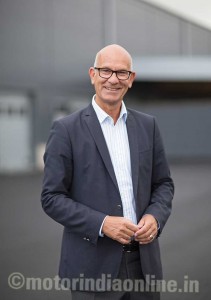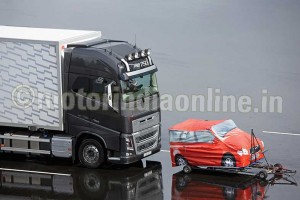The world’s first full-scale test environment for future road safety was inaugurated at Borås in Sweden on August 21. The AstaZero facility, as it is known, is owned by SP Technical Research Institute of Sweden and Chalmers. It will provide vehicle manufacturers, research institutes, universities and colleges from all over the world with unique opportunities to develop new solutions for increased road safety. The facility has cost about SEK 500 million.
A large number of accidents could be prevented if cars were equipped with active safety systems. These consist of sensors and advanced electronics which take over the driver’s role and make correct decisions at lightning speed enabling the car to brake, get out of the way and avoid head-on collisions. Autonomous, self-driving cars are another innovation which belong to the future.

Cars which act on their own initiative might sound like science fiction. However, a lot of technology has already been designed with ongoing related developments. The fact is that it is people who cause accidents, not slipperiness or fog. “If we can eliminate the human factor, we can also eliminate the number of accidents”, says Pether Wallin, CEO of AstaZero.
It will be possible to test all kinds of traffic and all traffic situations at AstaZero, from motorways to urban environments made up of blocks. Furthermore, the entire facility is connected. And in the future, our cars will be too. They will be able to communicate with each other, for example, to warn cars behind of slippery road surfaces.
“AstaZero will also be available for researchers and traffic experts who wish to improve safety for pedestrians, cyclists and other unprotected road users – an area that has taken a back seat”, says Pether Wallin.
Versatile testing facility
The facility, which has a total area of 2,000,000 sq. metres, accommodates a range of realistically constructed, continuous traffic environments such as highways, urban environments and a high speed track. Besides its size, the facility in Borås differs from other test arenas, in that it facilitates tests based on communication between the vehicle and surroundings.
The AstaZero facility helps the creation of different traffic scenarios in common traffic environments. At AstaZero it will be possible to perform a large number of tests: testing of driverless traffic, registration of the driver’s eye and steering movements, automatic braking in the event of sudden incidents such as a child running out in front of the car or hazards such as an elk suddenly appearing on the road, cyclists making turns, rapidly braking vehicles in front, the vehicle’s dynamic properties at high speeds, etc.
AstaZero comprises a drop-shaped high speed track called the drop. The track includes a four-lane motorway which is one km long, including an acceleration section. Among other things, lane changes and different collision scenarios are tested here. In total the drop is over 500 metres in diameter.
The facility also has an urban environment made up of blocks. Its use is primarily aimed at ascertaining how the car interacts with the surrounding environment: buses, cyclists, pedestrians, etc.
In addition, there is a 5.6 km highway. Highways are monotonous and the risk of the driver losing concentration is higher here than in, for example, urban driving. AstaZero’s highway includes obstacles such as animals crossing the traffic lane. The highway is largely used for tests in driver behaviour.
Towards ‘zero’ traffic vision
Every year 1.2 million people are killed in traffic globally, and between 20 and 50 million people are injured. The cost for medical care for those who are affected by traffic accidents is enormous and the number of accidents in traffic is expected to double by 2030. Traffic accidents will then be the fifth most common cause of death. AstaZero is a crucial step in achieving the vision of zero dead or seriously injured in traffic.
Active safety systems are tested at AstaZero. Active safety entails avoiding collisions and other incidents before they occur. The systems are based on equipping vehicles and infrastructure with technology which enable vehicles to communicate with each other and with the surrounding traffic environment. It might involve combining sensor technology, vehicle communication and vehicle computers.
Passive safety systems such as seat belts and air bags provide protection when an actual collision occurs. Active safety systems are being developed to prevent collisions and other incidents occurring. Some concrete examples are cars which warn vehicles behind of slippery road surfaces or give distraction alarms if the driver’s eyes are off the road for a long period or apply automatic braking if an elk suddenly runs out in front of the car.
Besides testing, AstaZero will also be used for customers’ research and development. For example, it can be used as an external development department for entire R&D projects. Researchers and traffic experts engaged in increasing safety for cyclists and pedestrians can also derive substantial benefit from the facility.
The development of technology for driverless vehicles has come a long way, and AstaZero will help envisage further steps forward. One example of tests with driverless vehicles is a test car that drives itself. Suddenly the robotically-controlled vehicle dummy in front reduces its speed sharply and at the same time the self-driving car has to have time to brake.
AstaZero is an international arena for future road safety, open for vehicle manufacturers, suppliers, legislators, universities and colleges from all over the world. The facility’s different environments entail a unique opportunity for research, development and certification of future road safety systems.
The name AstraZero stands for Active Safety Test Area and Zero, which refers to the Swedish Parliament’s vision for road safety with zero dead or seriously injured.
The facility is located at Borås and is jointly owned by the SP Technical Research Institute of Sweden and Chalmers. Official partners and financiers include AB Volvo, Volvo Cars, Autoliv, Scania, Västra Götaland Region, City of Borås, FFI, Swedish Agency for Economic and Regional Growth and Test Site Sweden.
Some of the customers using AstaZero for testing of future traffic solutions are AB Volvo, Volvo Cars, Autoliv, Scania and Test Site Sweden.


